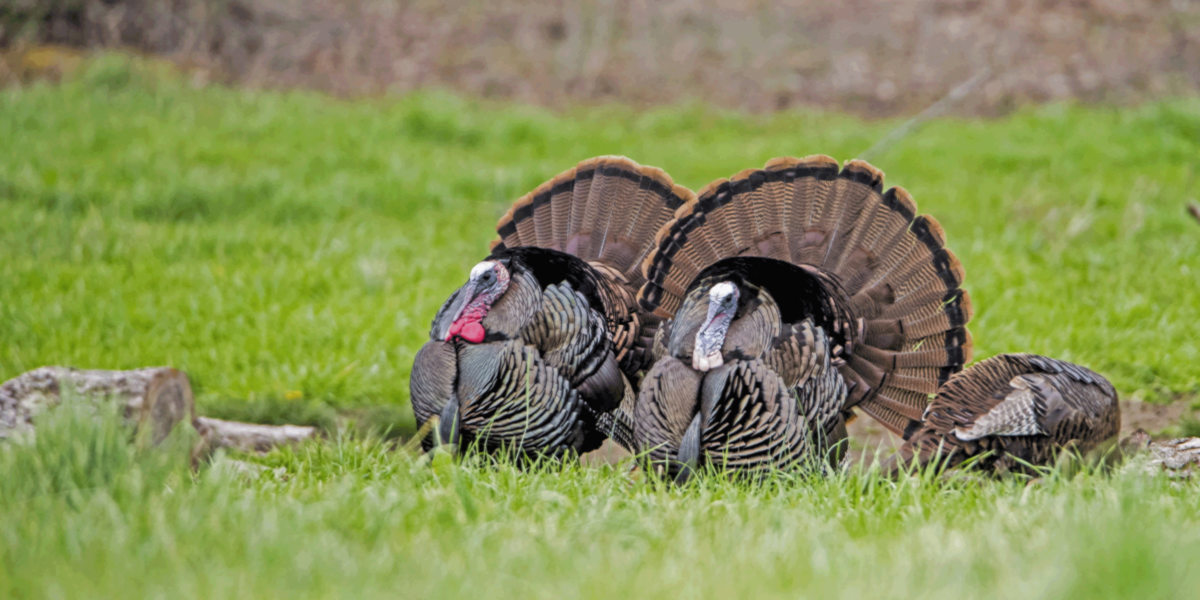How to Hunt Spring Turkey
This entry was posted on April22,2019.
SPRING TURKEY HUNTING

By the 17th of April, 2019, turkey hunting season will kick off in Minnesota and Wisconsin, and like all enthusiasts of this ancient sport, we’re super excited. Turkey hunting season lasts till May in both states, and whether you’re a veteran or a newbie in the turkey hunting game, it’s never a waste of time to learn about the peculiarities of turkey hunting in Minnesota and Wisconsin.
But first, a little refresher course for those who are a bit curious – where and how did turkey hunting start from?
Well, we have the Native Americans to thank for this one. Before European settlers got to America, they were already busy bow hunting turkeys. At a point, the turkey population in North America had all been decimated in the early 1900s. This would have been the end of this sport, if not for the intervention of several state governments to designate special seasons for hunting turkeys so that their population could be replenished. Today, more than 7 million wild turkeys roam all states of the US except Alaska.
With a wild turkey population of 85,000, mostly Easterns, Minnesota may not come to mind as the first choice when it comes to turkey hunting, but it’s a rapidly expanding territory for turkey hunting, something like a final frontier. Initially, turkey hunting was restricted to the Southeast hill country after they were reintroduced in the 1970s. Since then, they’ve expanded into the state’s central areas where there’s an extensive farmland-forest-prairie fringe country.
Annually, the state sells about 40,000 licenses for turkey hunting. Residents pay $26 for license and permit, while non-residents pay $100 for license and permit.
Turkey hunting is regulated by the Minnesota Department of Natural Resources. This year, they partnered with the National Wild Turkey Federation to organize a learn-to-hunt turkey program, which will take place on the 27th and 28th of April. Sorry to announce, but applications closed since February 21st.
Like we earlier said, the turkey hunting season starts from April 17th and ends by May. The season will be broken in to six roughly weeklong periods, with hunting periods tagged A through F. Hunting permits for periods A to B are determined by lottery. C to F are open to anyone with a license. Every turkey hunter is entitled to just one bird, which has to be registered when successful. Also, you’re only allowed to shoot male turkeys in the spring turkey hunting season.
Now for the hunting practical:
Wild turkeys have very sharp eyesight, so you can’t go there casually dressed and expect turkey waltzing around the countryside. If you want to catch them easily, you have to go fully kitted in your turkey hunting gear, which will usually consist of a camouflage turkey hunting vest. Apart from this, you also have to practice the art of making them give up their location, especially the male turkey. This is achieved by practicing the turkey call. When you simulate it, if they’re within earshot, they instinctively respond, thus giving away their position.

How do you this?
You could either drag a stick across a piece of slate rapidly or do what it called ‘the diaphragm call’ – this involves pressing the tongue on the roof the mouth, and making a loud noise, simulating the turkey call. You might not get it the first time, and it would also involve a lot of slobbering in the initial period, but don’t worry, practise makes perfect.
But note this, all because you’re able to simulate the turkey call and you’re well camouflaged, doesn’t mean you’re going to have an easy time killing a turkey. There are people who have been turkey hunting in Minnesota, and never killed a bird successfully for eight years, and some others, on their very first attempt, got a bird in just 5 minutes. There’s a lot of luck involved in turkey hunting. In 2017 alone, 49,919 licences were sold (remember a license allows you to kill just one bird) and only 11,854 turkeys were taken. That’s a success rate of about 24%.
Turkeys are a lot smarter than we give them credit for. They haven’t survived for centuries by waiting around to be shot. They’re tough, smart, and have sharp eyesight and hearing. An imperfect turkey call, stepping on the wrong twig at the wrong moment, and they have their heads cocked up in unison, giving each other warning signals, while they run for safety.
Win or lose, Minnesota is the happening place for turkey hunting. In the coming years, it’s only going to get bigger with a fast-growing turkey population. Whether you’re a first timer or a veteran turkey hunter, springtime in Minnesota is an adventure you don’t want to pass over.
TURKEY HUNTING IN WISCONSIN
Wisconsin is home to excellent turkey hunting opportunities, and an experience of a lifetime. It has a medley of farms and woodlots scattered throughout steep ridges, grassland, wetlands and valleys. Also, Wisconsin turkey hunting can equally be done from the edge of hardwood timber to open fields and river bottoms. Wisconsin also usually enjoys mild and affable winter, with below-average snowfall and temperatures such as is befitting and flourishing for turkeys, especially in the north, where winter is crucial for their survival. Unlike what one expects in Kansas turkey hunting or Texas turkey hunting. There is plenty of public land that makes hunting very stimulating, challenging and enjoyable.
Wisconsin’s modern era of wild-turkey hunting began in the early 1970s when the Department of Natural Resources (DNR) began restocking southwestern counties with birds from Missouri. Southwest area of Wisconsin was originally picked because it contained the proper habitat that wild turkeys need to thrive and prosper. This particular area is hilly and wooded with mostly oaks and other hardwoods that provide the turkeys with the food they need to survive in Wisconsin’s cold winters. Acorns (mast) and other nut-bearing trees provide much of the turkey’s food supply. The wooded hillsides give turkey good roosting spots out of the wind and cold of winter. There also are agricultural fields mixed in with the wood lots and the waste and unharvested grain can provide valuable food at critical times, making hunting memorable.
There are other locations in central Wisconsin that also have excellent turkey populations (including Vernon, Crawford, and Grant Counties and all border the Mississippi River). Other relatively good turkey counties are just east of the above counties that they all border. They include, Lafayette, Iowa, Richland, Sauk and Dane. But, some of the counties are close to larger cities and towns and public hunting areas may be crowded. Turkey hunting is most of the state is very good, particularly the southern half of Wisconsin.
The National Wild Turkey Federation (NWTF) revealed that during summer, the numbers of turkey are usually stable even in response to changes in predation, weather and habitat. There are therefore all indicators Wisconsin’s turkey population is solid, and basically mirrors what’s occurring from Canada through Mexico. The NWTF’s number help explain why Wisconsin maintains one of North America’s strongest turkey populations. According to the data by Wisconsin’s DNR, 135,202 harvest authorizations have been issued for 2019 spring turkey hunt.
The State of Wisconsin’s Department of Natural Resources require that all persons interested in hunting Wisconsin Wild turkeys must apply for a turkey permit. You need to apply for a Spring permit in that Management Zone and time period of choice. The permits when issued would be known so as to ensure that hunters can be aware if there are successful or not. Along with a spring turkey harvest authorization, a valid spring turkey license and wild turkey stamp is required to hunt turkey in Wisconsin. Stamp and licenses may be purchased online or in person at any license agent or DNR service centers, at the start of license year. Turkey hunting is becoming very keener as license/stamp is very affordable.
The DNR at the beginning of March 18th for the state’s 2019 turkey hunting season made over a hundred thousand leftover turkey hunting permits available. According to the DNR, the lingering winter weather reduced the turkey harvest in the youth hunt and first time period of the regular hunt in 2017. Overall, Wisconsin’s state-wide wild turkey population remains strong. This population has continued to thrive, and it is anticipated the next hunting spree would be successful. In a summative evaluation of it all, aside a tough spring turkey season and a smaller flock in recent times, Wisconsin remains one of North America’s best areas for turkeys and turkey hunting.
SO WHAT NEXT?
You can do well to avail yourself of turkey hunting videos on YouTube to find out about turkey hunting games and turkey hunting seasons across counties and states. Also, you will see how most hunter make turkey calls for hunting; hunting tips perhaps different from Minnesota turkey hunting. Although, Nebraska, Michigan, Colorado, Kansas, and other States turkey hunting may differ slightly in operation, the experience and fun are refreshing.
Turkey hunting is such a great and safe sport for a variety of people. Watching turkey hunters as they trail and hunt excitingly gobble rattling turkeys through tree and fields could be very thrilling and really adventurous. You too, can join the hunting spree and experience first-hand the intrigues and joy in turkey hunting. Become a player, not a spectator!
